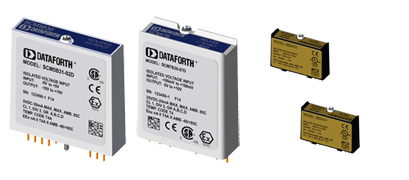Why Should Sensors Be Isolated
Tech Note
Connecting a physical sensor to a data acquisition system is a serious undertaking.
A laboratory connection may work well when connected with short wires in a benign environment.
When mounted in the real world of electromagnetic signals and repetitive or one time emissions, several things should be considered.
These topics are covered in much greater detail in Dataforth application note AN116, Why Use Isolated Signal Conditioners .

Overvoltage
Often overlooked is accidental connection to power line voltages. Inside a busy electronics cabinet this can easily happen either by an installation mistake or a dropped wire. Yes, some people have been known to work wiring hot. An isolation barrier will prevent a harmful voltage from getting into sensitive circuitry. Dataforth’s signal conditioning products provide a 1500V withstand barrier between the sensor and a user system. In addition they are designed to withstand connection to power line voltages without damage to themselves.
Crosstalk
Careless wiring and cabling can obviously cause problems. With good practices in the field, crosstalk still must be considered; because some sensors and long wire runs present a moderate to high impedance to a data collection point. Even active or smart sensors that present higher voltages and low output impedances need some consideration of possible crosstalk. Twisted wire pairs and shielding are the best practice. Remember that wiring capacitance adds to the output capacitance at the receiving end. Multiplexers allow one channel to interfere with another channel due to charging these capacitive effects. A signal conditioning amplifier presents a low resistance and small, uniform capacitance to the system multiplexer.
Common Mode Voltage
Common mode voltage, CMV, is a voltage applied to both signal wires. Even with coax, the user is still dealing with two current paths and CMV may be present. Normal mode voltage, NMV, is applied to only one wire, a current path. More exactly it is the difference of separate voltages on each wire. If the sum of CMV and NMV exceed the operating range of a system multiplexer, the data for that channel is invalid. Higher voltage can or will damage the multiplexer. Even a slight over voltage can bleed over and corrupt all channels of that multiplexer. A signal conditioning amplifier will protect multiplexers and should be designed to withstand large voltage outside of their full scale range without damage.
DC Common Mode Rejection
When common mode signals are within the operating range of receiving equipment, the presence of even this voltage must be considered. Remember that single ended inputs are not designed to allow any common mode voltage. Differential, double ended, inputs do allow common mode voltage to be rejected to a sometimes acceptable degree, perhaps 80dB. However, even this seeming large number is not adequate when low level sensor signals must be highly amplified. Total DC CMV, rejection can be provided by the isolation barrier of a signal conditioning amplifier.
AC Common Mode Rejection
If DC common mode rejection can be a problem, AC CMV is even harder to control. The smallest imbalance of capacitance can destroy common mode rejection at 50 to 60Hz. A capacitance as low as 1 to 2 picofarad, or even less, can be important. This is especially true for higher signal bandwidth. Many design engineers have found that even after the most careful considerations, a tiny balancing capacitor is useful as a finishing touch. Often this may be done with printed circuit board conductor geometry. A carefully designed signal conditioning amplifier helps with this.Dataforth signal conditioning amplifiers answer much of the problems described here. Much more detail is provided in Dataforth application note AN116, Why Use Isolated Signal Conditioners. Also see Dataforth application note AN108, When Good Grounds Go Bad.
Was this content helpful?
Thank you for your feedback!






